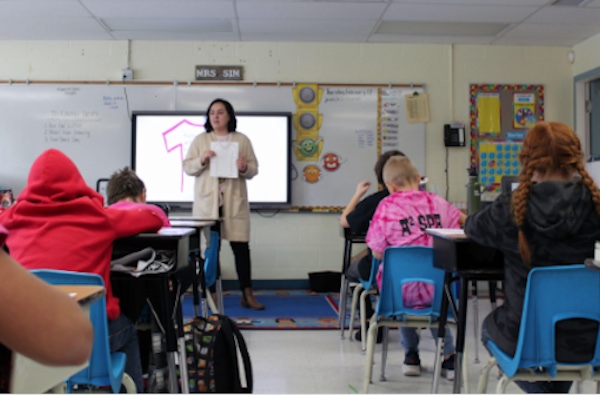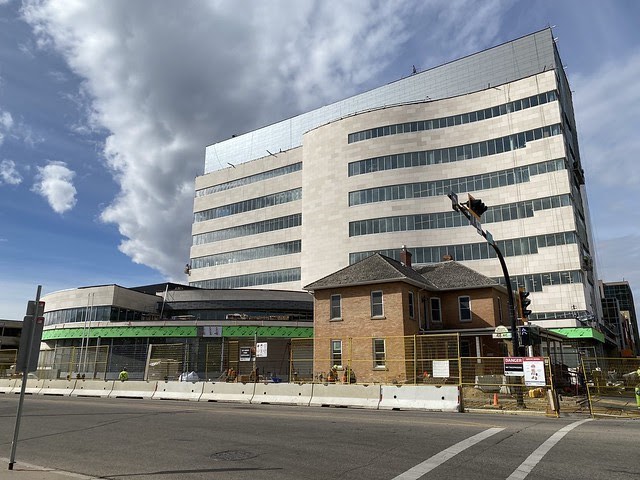Alberta
First year teacher from Aspen Heights Elementary up for provincial award

Building relationships key to successful first year Teacher Tosha Sim
Tosha, a first year teacher at Aspen Heights Elementary, has been named Red Deer Public’s nominee for the prestigious Edwin Parr Teacher Award.
Each year the Alberta School Boards Association honours six outstanding first-year teachers with the Edwin Parr Teacher Award. School boards may nominate any first-year Kindergarten to Grade 12 teacher who has taught in an Alberta school jurisdiction which is a member of the ASBA.
Rob Moltzahn, Associate Superintendent of Human Resources for Red Deer Public, said Tosha was chosen as this year’s nominee because she is a reflective and creative teacher whose students are enthusiastically engaged in the classroom.
“Red Deer Public has fantastic teachers from our first years to our veterans, allowing students to benefit from this wealth and depth of knowledge,” he said. “Tosha is clearly passionate about teaching. Her interaction and connection with students was remarkable to see. Tosha took care of the needs of all students in her class without missing a beat.”
For Tosha, she said the nomination took her by surprise.
“The special part was that my principal, Bill Kwasny, said in his whole career that he’s never nominated a first year teacher before. It was really cool,” she said.
Tosha has had a lifelong dream of becoming a teacher, and remembers Career Days in elementary school where she would dress up as a teacher.
“I truly love everything about being a teacher. There isn’t a day where I don’t want to get up and come to work,” said Tosha, who currently teaches a Grade 4/5 combined class. “It’s incredible to be part of each of my students’ lives at this time in their life and help mold them into the beautiful people they will be. It’s amazing – I can’t imagine not teaching.”
Growing up, relationships with teachers were an integral part of Tosha’s school years, and played a significant role in her decision to pursue teaching as a career.
“I can name off every single teacher in my life, and there are some that have been so special,” she said. “Being taught by phenomenal teachers has given me a solid platform as I begin my career and I’m very grateful for that.”
Since being in her classroom since last fall, Tosha said seeing her students learn and grow has been extremely fulfilling.
“It’s been amazing to see where they are now compared to where they were in the fall. Their growth in learning has been incredible to see.”
Last July, Tosha taught at Reading College, a program of the Foundation for Red Deer Public Schools, which helps Grade 2 students who are struggling readers become readers of potential. It was an experience she will never forget, and will always be grateful for.
“I will sing Reading College’s praises for my whole life,” she said. “It was an incredible experience. I think the biggest part was learning how to build those relationships in those four weeks – it really helped me in my classroom now. And helping kids develop a love of reading will play a part in the rest of my career as well!”
Bill Kwasny, Principal at Aspen Heights Elementary School, said Tosha has been an excellent addition to Aspen Heights Elementary.
“She has built a classroom that is caring, inclusive and safe,” he said. “Her students know that she cares deeply for them and she respects and values their differences.Her students have celebrated her nomination and feel pride that they are responsible, in part, for her success. Tosha’s passion for teaching is apparent for the time you first step foot in her classroom. It is a pleasure having the opportunity to work with Tosha.”
Alberta
Red Deer Justice Centre Grand Opening: Building access to justice for Albertans

The new Red Deer Justice Centre will help Albertans resolve their legal matters faster.
Albertans deserve to have access to a fair, accessible and transparent justice system. Modernizing Alberta’s courthouse infrastructure will help make sure Alberta’s justice system runs efficiently and meets the needs of the province’s growing population.
Alberta’s government has invested $191 million to build the new Red Deer Justice Centre, increasing the number of courtrooms from eight to 12, allowing more cases to be heard at one time.
“Modern, accessible courthouses and streamlined services not only strengthen our justice
system – they build safer, stronger communities across the province. Investing in the new Red Deer Justice Centre is vital to helping our justice system operate more efficiently, and will give people in Red Deer and across central Alberta better access to justice.”

Government of Alberta and Judiciary representatives with special guests at the Red Deer Justice Centre plaque unveiling event April 22, 2025.
On March 3, all court services in Red Deer began operating out of the new justice centre. The new justice centre has 12 courtrooms fully built and equipped with video-conference equipment to allow witnesses to attend remotely if they cannot travel, and vulnerable witnesses to testify from outside the courtroom.
The new justice centre also has spaces for people taking alternative approaches to the traditional courtroom trial process, with the three new suites for judicial dispute resolution services, a specific suite for other dispute resolution services, such as family mediation and civil mediation, and a new Indigenous courtroom with dedicated venting for smudging purposes.
“We are very excited about this new courthouse for central Alberta. Investing in the places where people seek justice shows respect for the rights of all Albertans. The Red Deer Justice Centre fills a significant infrastructure need for this rapidly growing part of the province. It is also an important symbol of the rule of law, meaning that none of us are above the law, and there is an independent judiciary to decide disputes. This is essential for a healthy functioning democracy.”
“Public safety and access to justice go hand in hand. With this investment in the new Red Deer Justice Centre, Alberta’s government is ensuring that communities are safer, legal matters are resolved more efficiently and all Albertans get the support they need.”
“This state-of-the-art facility will serve the people of Red Deer and surrounding communities for generations. Our team at Infrastructure is incredibly proud of the work done to plan, design and build this project. I want to thank everyone, at all levels, who helped make this project a reality.”
Budget 2025 is meeting the challenge faced by Alberta with continued investments in education and health, lower taxes for families and a focus on the economy.

Quick facts
- The new Red Deer Justice Centre is 312,000 sq ft (29,000 m2). (The old courthouse is 98,780 sq ft (9,177 m2)).
- The approved project funding for the Red Deer Justice Centre is about $191 million.
Alberta
Made in Alberta! Province makes it easier to support local products with Buy Local program

Show your Alberta side. Buy Local. |
When the going gets tough, Albertans stick together. That’s why Alberta’s government is launching a new campaign to benefit hard-working Albertans.
Global uncertainty is threatening the livelihoods of hard-working Alberta farmers, ranchers, processors and their families. The ‘Buy Local’ campaign, recently launched by Alberta’s government, encourages consumers to eat, drink and buy local to show our unified support for the province’s agriculture and food industry.
The government’s ‘Buy Local’ campaign encourages consumers to buy products from Alberta’s hard-working farmers, ranchers and food processors that produce safe, nutritious food for Albertans, Canadians and the world.
“It’s time to let these hard-working Albertans know we have their back. Now, more than ever, we need to shop local and buy made-in-Alberta products. The next time you are grocery shopping or go out for dinner or a drink with your friends or family, support local to demonstrate your Alberta pride. We are pleased tariffs don’t impact the ag industry right now and will keep advocating for our ag industry.”
Alberta’s government supports consumer choice. We are providing tools to help folks easily identify Alberta- and Canadian-made foods and products. Choosing local products keeps Albertans’ hard-earned dollars in our province. Whether it is farm-fresh vegetables, potatoes, honey, craft beer, frozen food or our world-renowned beef, Alberta has an abundance of fresh foods produced right on our doorstep.
Quick facts
- This summer, Albertans can support local at more than 150 farmers’ markets across the province and meet the folks who make, bake and grow our food.
- In March 2023, the Alberta government launched the ‘Made in Alberta’ voluntary food and beverage labelling program to support local agriculture and food sectors.
- Through direct connections with processors, the program has created the momentum to continue expanding consumer awareness about the ‘Made in Alberta’ label to help shoppers quickly identify foods and beverages produced in our province.
- Made in Alberta product catalogue website
Related information
-

 2025 Federal Election2 days ago
2025 Federal Election2 days agoPolls say Canadians will give Trump what he wants, a Carney victory.
-

 2025 Federal Election2 days ago
2025 Federal Election2 days agoPoilievre’s Conservatives promise to repeal policy allowing male criminals in female jails
-

 2025 Federal Election2 days ago
2025 Federal Election2 days agoCarney Liberals pledge to follow ‘gender-based goals analysis’ in all government policy
-

 2025 Federal Election2 days ago
2025 Federal Election2 days agoTrump Has Driven Canadians Crazy. This Is How Crazy.
-

 Entertainment1 day ago
Entertainment1 day agoPedro Pascal launches attack on J.K. Rowling over biological sex views
-

 2025 Federal Election2 days ago
2025 Federal Election2 days agoThe Anhui Convergence: Chinese United Front Network Surfaces in Australian and Canadian Elections
-

 conflict1 day ago
conflict1 day agoTrump tells Zelensky: Accept peace or risk ‘losing the whole country’
-

 2025 Federal Election1 day ago
2025 Federal Election1 day agoPoilievre Campaigning To Build A Canadian Economic Fortress





